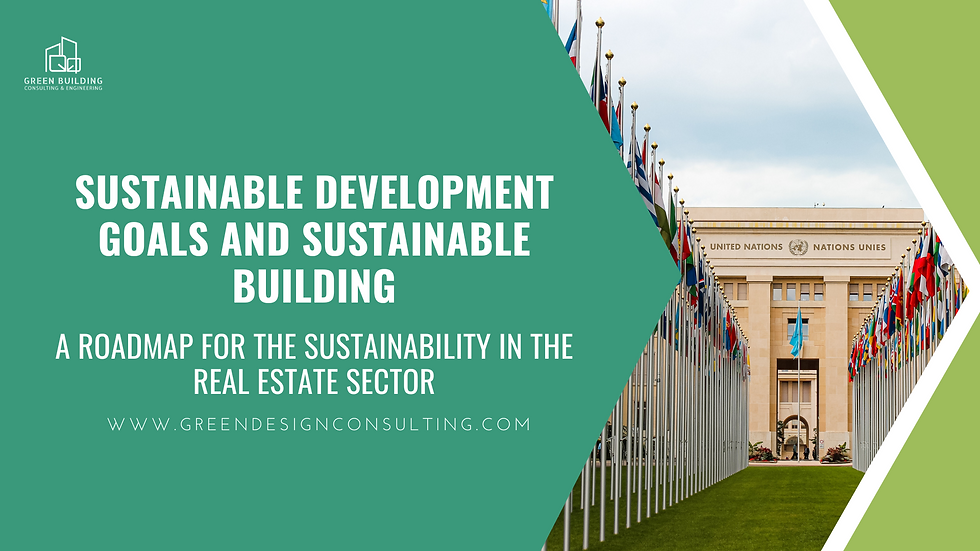Sustainable Development Goals (SDGs) and Sustainable Building
- project1253
- Aug 9, 2023
- 4 min read

A roadmap for the sustainability in the real estate sector
The United Nations' Sustainable Development Goals (SDGs) and the concept of sustainable building might seem distinct at first glance, yet they are profoundly interconnected.
Global Vision of Synergy Between SDGs and Sustainable Building
The UN's SDGs represent a global call to action for the enduring transformation of societies. They offer a framework to address intricate and interconnected challenges through the lens of sustainability, particularly impacting the building sector by promoting a virtuous mode of construction. This interrelation between SDGs and sustainable building is profound and multifaceted, spanning social, environmental, and economic dimensions.
Global and Local Perspective
The SDGs provide a perspective that transcends borders, advocating for global action while remaining relevant at the local level. Sustainable building, guided by the SDGs, has the potential to create spaces that address local needs while contributing to global objectives. For instance, SDG 11, aiming to establish sustainable cities and communities, can be realized through buildings utilizing local resources (circular economy), reducing energy consumption (environmental concern) and fostering social cohesion (social dimension).
Interconnected Objectives
The interconnected nature of SDGs demands that sustainable building reflects this complexity. Sustainable building surpasses mere energy efficiency; it must also support health and well-being (SDG 3) and quality education (SDG 4) by providing suitable air quality, acoustics, and thermal conditions essential to achieving these objectives. Building sustainability is also intertwined with combating poverty (SDG 1) as energy vulnerability primarily affects the poorest households living in energy-inefficient housing. Such interconnections necessitate profound contemplation and careful planning.
Innovation and Transformation
Sustainable building requires continual innovation, entailing industry transformation and the creation of new opportunities. Concepts like Smart Cities and Smart Buildings, for instance, revolutionize how we live and work, contributing to innovation and economic growth (SDGs 8 and 9). They enable energy consumption monitoring, precise data provision to tackle issues like energy overconsumption, while enhancing user health and lifestyles.
Challenges and Opportunities
The SDGs offer both challenges and opportunities. They demand long-term thinking and action, urging collaboration between governments, industry, and civil society. Simultaneously, they provide an opportunity to rethink how we construct and inhabit spaces.
In essence, SDGs are more than a mere list of UN-defined objectives; they compel us to reshape our models to be more socially, environmentally, and economically sustainable. Applied to real estate, they pave the way for constructing and managing buildings more sustainably, aiming to mitigate negative impacts and externalities. Due to their multidimensional nature, they foster holistic building considerations and promote collaboration among all stakeholders. SDGs foster comprehensive reflection on current challenges, urging sector participants to innovate and collaborate to surmount them.
II. Reflections and Observations
The relationship between SDGs and sustainable building extends beyond achieving individual objectives. It represents a profound transformation in how we conceive, construct, and inhabit spaces, prompting crucial contemplations that have emerged in recent years.
Balancing Objectives
Striking a balance among various SDGs in the context of sustainable building poses a significant challenge. How can energy efficiency (SDG 7) coexist without compromising health and well-being (SDG 3)? How can quality education (SDG 4) and poverty reduction (SDG 1) be integrated into design and construction? Such questions require a holistic and integrated approach. For example, in France, to incorporate social concerns into sustainable buildings, a new profession has emerged in recent years: "user assistance", serving as a mediator and coordinator between future users and project management. Another other of those roles is the green building consultant, which delegates environmental responsibilities to ensure alignment with the project's environmental aspects.
Collaboration and Partnership
As previously mentioned, achieving SDGs through sustainable building necessitates close collaboration among governments, industry, civil society, and local communities. SDG 17, calling for partnerships to achieve objectives, is crucial here. The aim is to create synergies and work together toward common goals. Involving multiple stakeholders in a project is a way to design sustainable buildings that meet everyone's requirements while offering solutions adapted to challenges. For instance, involving users from the design phase empowers project management to address social and societal issues. Additionally, municipalities might initiate urban brownfield rehabilitation through calls for projects, fostering collaborations that repurpose outdated and often polluted urban land for sustainable solutions, enhancing urban resilience.
Adaptation and Flexibility
The world is changing rapidly, and sustainable building must adapt accordingly. Whether in response to climate change, new technologies, or evolving community needs, flexibility and adaptability are paramount. Concepts like modularity or chronotopy are increasingly popular in sustainable design, placing building evolution at the core of the design process, ensuring operational efficiency over the building's lifespan with simplified technical means.
Measurement and Evaluation
How do we measure success? How can we evaluate whether a building or community is truly sustainable? Implementing clear metrics and assessments aligned with SDGs is crucial to ensure progress is made and lessons are learned. While some objectives might seem more subjective than others, the challenge lies in finding suitable Key Performance Indicators that are less subjective, enabling effective progress tracking.
In conclusion, the relationship between SDGs and sustainable building promises a path toward a more sustainable future. Yet, it is complex and rife with challenges. It requires deep contemplation, close collaboration, a drive to innovate and a determination to act. This reflection encourages departing from the status quo and reinventing ourselves, spurring the emergence of new roles in the sector. It's a journey worth undertaking, as it has the potential to transform not only our buildings but also our societies.
Are you planning to label one or more commercial buildings and need some support? Contact us today to find the right solutions for your needs!
Sources :














Comments